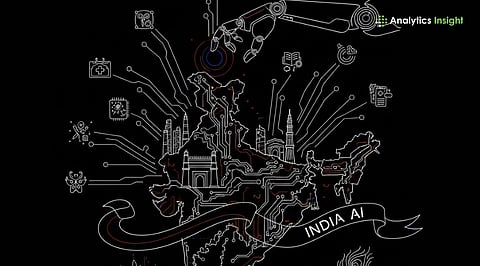

In 2025, India shaped its AI journey with bold moves and deep ambition. It shifted from testing the waters to using real power. What began as pilot projects mushroomed into large‑scale integrations across public systems and business workflows. The IndiaAI Mission emerged as a backbone. BharatGen AI made its debut. Ethical governance found centre stage. This was not just about technology, but about bringing AI to every citizen.
The IndiaAI Mission pushed hard to democratize access to powerful compute resources. By May, India’s national compute capacity crossed 34,000 GPUs, according to government data. This created a shared AI platform that allowed startups and researchers to build models without being constrained by hardware scarcity. The mission also selected three new startups, Soket AI, Gnani AI, and Gan AI, to build foundational, India‑centric models.
That compute boost came with a massive investment. Over Rs. 10,300 crore was allocated to the IndiaAI Mission over five years. This funding aimed not just at infrastructure, but also at talent, safety, and data access.
On June 2, 2025, the government launched BharatGen AI, its first multimodal large language model built to work across 22 Indian languages. Developed at IIT Bombay under a national mission, BharatGen integrates text, speech, and image, making AI deeply rooted in Indian culture and values. The goal: use this model to transform sectors like healthcare, education, and governance, adapting AI to local needs.
2025 marked a tipping point for business adoption. According to an EY‑CII report, 47% of Indian enterprises now run multiple generative AI use cases in production. This leap from pilots to performance signaled growing confidence. Many leaders (76%) saw generative AI as a major force shaping their future, and 63% said they were ready to leverage it.
Despite that optimism, budgets remained cautious. Most companies kept AI spending under 20% of their IT budgets. Still, speed mattered more than cost. Nearly 91% of decision-makers said rapid deployment was key to their AI strategy.
India’s approach to AI in 2025 is based on ethical principles. The IndiaAI Mission emphasized responsible AI, safe frameworks, and transparent development. Policymakers and industry players recognized that building trust would matter more than hype. The nation’s commitment to inclusive innovation meant not only access to compelling technology but also accountability, fairness, and public benefit.
AI’s reach in 2025 wasn’t limited to high-end labs or big enterprises. The mission placed strong emphasis on serving the informal sector. Reports from NITI Aayog highlighted how AI tools could uplift millions of informal workers by providing access to healthcare, financial inclusion, education, and skilling. The government also backed Centers of Excellence focused on research and capacity-building in key sectors such as agriculture, healthcare, and education.
Bhashini, India’s multilingual AI platform, gave a big boost to language accessibility. In June 2025, Bhashini signed an MoU with the Centre for Railway Information Systems (CRIS) to provide services in 22 languages at railway stations across the country. Such partnerships helped strengthen support and lower the language barrier for millions of Indians.
By the end of 2025, India had laid a solid foundation for AI's future. That foundation combined infrastructure, indigenous models, active business deployment, and deep ethical focus. But challenges remain: research quality must improve, private investments must scale, and long‑term governance must deepen. Still, the direction is clear: India is not just a consumer of AI, but a builder of AI that mirrors its diversity and ambition.
The year 2025 will be remembered as a watershed moment in India’s AI transformation. From the IndiaAI Mission’s compute surge to the launch of BharatGen AI, from enterprise adoption reaching scale to a robust focus on responsible and inclusive AI, this was the turning point. The groundwork laid today promises not just economic gain, but social equity. As India marches ahead, it does so with technology that serves its people, languages, and future.
